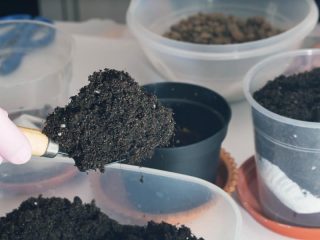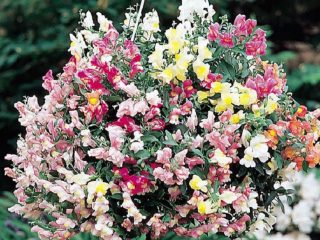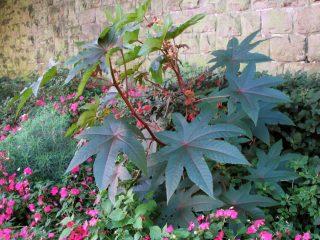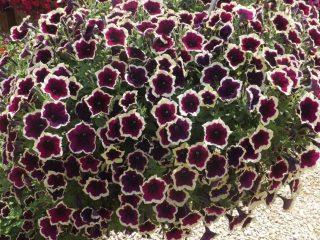Content
When looking for a bright and unusual flower, you should pay attention to the photo of the malopa (hole). The culture is rare in northern latitudes and is considered an exclusive species. It can be grown at home or in a country plot.
What do malopa flowers look like?
The height of the annual plant is from 0.4 to 1 meter. Its size depends on the characteristics of the particular variety. The stems are branched, the resulting leaves are heart-shaped.

Small notches form along the edges of the edging
Flowers grow singly. In most cases, the corolla is formed by five petals, with about 50 small seeds formed inside.
Malopa attracts the attention of lovers of unusual and rare plants. Under unfavorable climatic conditions, growing a flower is possible at home.

Large funnel-shaped flowers are considered the most attractive feature
Types and best varieties
Conventionally, the plant is divided into three types. There are Malope anatolica, Malope trifida and Malope malacoides. Among them there are several popular varieties:
- Diamond Rose. Characterized by beautiful flowers. Attracts attention due to its height of about 0.9 meters.
Diamond rose develops quickly under favorable conditions
- Purpurea. The malopa variety is popular because of its unusual buds.
The petals of the Purpurea variety are painted in bluish-red tones.
- Belyan. The flower petals have snow-white shades of purple.
The Belyan variety resembles snowballs in the summer
- Purple malopa. Attracts attention with its size. The height of the stems reaches 120 cm. The flowers are large. Their diameter is about 12 cm.
Purple malopa petals are uniform pink color
- Glaser. This variety is considered a hybrid. The color of the malopa is heterogeneous.
White, pink, black and burgundy shades may appear on the Glaser variety
- Gorgeous. It differs from other varieties in its large size.
The diameter of Beauty's petals reaches 10 cm
All varieties are characterized by large flowers with large petals. Therefore, they are often chosen as the central element of a flower arrangement.
Growing malopa seedlings from seeds
Malopa is often grown from seeds at home. Planting material must be prepared in advance. It is advisable to purchase seeds from trusted stores, since the crop is quite rare.
When to plant malopa seedlings
Like all annuals, the flower reproduces by seeds.The prepared material retains its ability to germinate for four years after collection. When choosing a suitable planting time, they are guided by climatic conditions. The plant is planted in open ground from April to May. The main condition is that there should be no night frosts.
You can grow malopa seedlings yourself at home:
- The collected seeds are sown in a container with loose peat soil. The grains are only slightly pressed into the soil; they are not sprinkled on top.
- The soil is sprayed with water and covered with film or glass.
- When growing, you need to maintain high humidity. The film is removed only after the first shoots appear. Watering should be moderate; plants require good lighting to develop.
After some time, when 2-3 petals appear, the seedlings dive into separate cups
Landing rules
Malopa is transplanted to a permanent place in the garden only after warm weather sets in. In order for the seedlings to take root well, organic fertilizers are applied before this.
Small holes about 10 cm deep are prepared for planting material. The minimum distance between them should be 30-35 cm.
Sowing in open ground
In a favorable climate, it is possible to plant malopa directly in open ground. To do this, follow several recommendations:
- Before planting, grooves are created in the selected area in increments of 30 cm;
- the grain is placed in the recess and sprinkled with a little;
- germination takes about two weeks;
- After germination, the planting site is periodically thinned out.
Watering is carried out as needed. When the malopa grows a little, the ground is slightly loosened. The frequency of watering is reduced.
Caring for small grass in the open ground
The plant is undemanding to soil composition. But applying fertilizer will lead to the appearance of a large number of flowers. It is recommended to plant the crop in a sunny place in the garden. The seedling develops safely only with minimal shading. Usually, planting and caring for malopa in open ground does not cause difficulties.
Watering
Malopa is considered an unpretentious plant. Watering is only needed in dry weather. The recommended frequency is three times a week.
On rainy days there is no need for irrigation.

Too high humidity causes the development of fungal diseases
Top dressing
When the soil is depleted, complex fertilizers are applied. Recommended frequency: 2-4 weeks during the growing season and flowering period. It is not recommended to add organic compounds.
Trimming
You should pinch the malopus to remove excess shoots. Pruning is carried out to form a neat bush. The flowers are often cut to create bouquets.
The buds bloom periodically. Withered flowers need to be cut off so that new ones appear faster.
Reproduction methods
Annual plants are propagated only by seed. Each flower produces about 50 small seeds. They need to be collected carefully, as pressing hard can damage the planting material.
Diseases and pests
An attractive annual flower characterized by durability. But some harmful organisms can cause the death of the plant. Most often, malopus is attacked by:
- Spider mite. It attacks the malopa, depriving it of all nutritional juices. The leaves begin to turn yellow and become deformed.
Treatment for spider mites consists of spraying with insecticidal solutions, for example, Actellik
- Nematodes. They attack the underground part of the flower.
To get rid of the nematode, the drugs Karbofos and Nemagon are used
- Aphid. It attacks in entire colonies, as a result the plant weakens almost immediately. You can notice the pest on the back of the leaves. First, insects are shaken off the stems onto a small sheet of paper located under the bush. Next, the flower is treated with insecticides.
An effective remedy against aphids - Aktara
If the rules of planting and care are violated, the flower may get sick. Dangerous diseases are considered:
- Rust. This disease can be noticed by the spots that appear on the leaves. Treatment involves the use of Bordeaux mixture or Fitosporin.
Leaves damaged by rust are removed
- Powdery mildew. The disease occurs when care rules are violated, usually in the case of high humidity.
You can get rid of the disease by using fungicidal drugs - Bordeaux mixture, Fitosporin, etc.
Malopia should be observed during the flowering period. When the first signs of pest attack or disease appear, the plant is treated.
Malopa in landscape design
Malopa has recently been often used in landscape design. Depending on the characteristics of the chosen variety, the flower is suitable for creating various artistic compositions.

Malopa is planted against the backdrop of wicker fences and picket fences; you can choose a place near the pedestrian path

You can create compositions from several different varieties of malopa.
You can combine the culture with other plants. Chamomiles, zinnias, dahlias and many others are suitable for this. The main thing is to take into account the color scheme, size ratio and flavor characteristics.
Conclusion
Photos of malopa attract many owners of suburban areas. This flower has become popular due to its large petals and unpretentiousness to growing conditions. You can prepare planting material yourself; the seeds do not lose their viability for four years.
Reviews about growing malopa






















